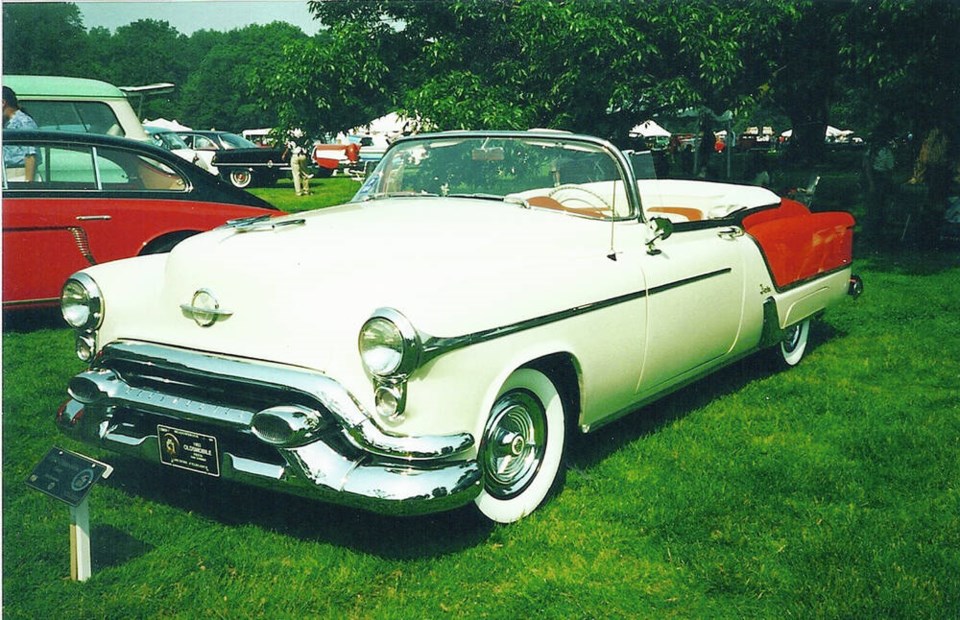The 1950s were the best of times for General Motors. After taking sales leadership from Ford in 1931 under the brilliant presidency of Alfred P. Sloan, Jr., GM combined a hierarchy of brands with the annual model change to lure buyers from a Chevrolet up the ladder, to hopefully, a Cadillac. In the process it became king of American car companies.
GM’s share of the American market averaged 41 per cent in the 1930s, 44 in the 1940s and 46 in the 1950s. In some years during the 1950s it was over 50 percent.
With designs led by gifted chief stylist Harley Earl it’s not surprising that GM set the styling trend. Its annual travelling Motorama shows featured current models and concept cars, often called “Dream Cars.”
Their purpose was to test public opinion on new styling and engineering features. Starting in 1949 Motorama travelled to major cities exhibiting the automotive future as envisaged by a highly confident General Motors.
Two early concept Motorama cars were the Buick LeSabre and Buick XP300 sown in 1951. They previewed such items as wraparound windshields and sleek aircraft influenced lines. One Motorama car, the Chevrolet Corvette, actually went into production in 1953.
Also in 1953 GM’s three senior divisions, Cadillac, Buick and Oldsmobile, wanted something special to celebrate their more than 50 years in the automobile business.
They decided to produce limited production “dream cars for the showroom.” These were the two-door Cadillac Eldorado, Buick Roadmaster Skylark, and Oldsmobile Ninety-Eight Fiesta. All were convertibles and all were expensive. If limited production was the test of exclusivity, the Fiesta was the most exclusive of all.
The Oldsmobile Fiesta was based on the standard Ninety-Eight model to which it bore a strong resemblance. There were, however, many subtle differences, including a lowered wraparound windshield, a dip in the body just behind the doors and distinctive badging.
The dramatically curved “Panoramic” windshield required a modified instrument panel, and the cut down windshield meant a lower convertible top had to be designed. This reduced the overall height, which also required new doors and windows.
One of the Fiesta’s most distinctive features was its three-spoke “spinner” wheel covers. They would be adopted by other Olds models and would become very popular aftermarket items.
Oldsmobile chose an appealing two-tone paint treatment for the Fiesta, making all of the body except the upper part of the rear fenders and the deck lid in a base colour. It was a more attractive application than some of the garish two- and three-toning of the 1950s.
As expected of an upscale model the Fiesta was fully equipped for its era, including Hydra-Matic transmission and power brakes, steering, top, windows and seat. The “Wonder Bar” signal-seeking radio had a foot-operated station changing switch and a power antenna.
The Fiesta was a big car at 5,461 mm (215 in.) long with a 3,150 mm (124 in.) wheelbase. It weighed a hefty 2,018 kg (4,450 lb). Power came from Oldsmobile’s 5.0-litre (304 cu in.) overhead valve “Rocket” V-8 engine with a slightly higher compression ratio than the standard Ninety-Eight. This raised horsepower from 165 to 170. It also got the division’s new 12-volt electrical system.
Oldsmobile introduced the Fiesta as a mid-year model in the spring of 1953. It was assembled in Oldsmobile’s ancestral home of Lansing, Michigan, and the extensive application of custom work made it almost a hand-built car. The result was a price approaching $6,000, more than $2,500 above regular top-of-the-line Oldsmobiles.
The Fiesta was built for the 1953 model year only, and the high price combined with a short selling period resulted in the production of just 458. Given the amount of custom work required on the Fiesta, however, it’s unlikely production could ever have been very high even if the market was there.
Cadillac built 532 of its Eldorados, while the Buick Skylark’s sales of 1,690 were the highest 1953 production of the three special soft-tops. Cadillac and Olds made their versions for 1953 only, but Buick liked its Skylark so much it carried it on for 1954.
It’s unlikely the three divisions made a profit on these ultra-luxury models. Due to the Fiesta’s low production, Olds likely lost the most. But the object was not necessarily to make a profit, it was to produce exciting vehicles.
They were virtual dream cars for the street, showroom magnets to attract more of the public into dealerships where they would hopefully then buy lesser models.
Many of the Fiesta’s styling features such as the wraparound windshield, body dip and spinner wheel covers would find their way onto standard Oldsmobiles and others.
The Oldsmobile Fiesta is largely forgotten now, but those who remember it will recall a very exclusive and luxurious carriage that makes a rare and popular collectible.



